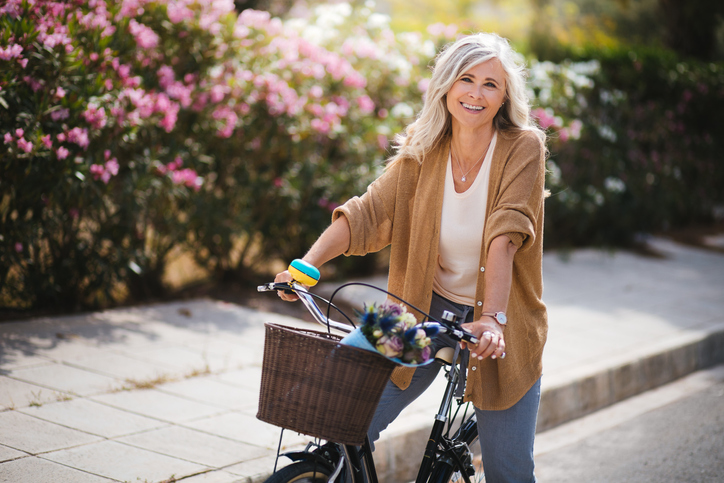We’ve all heard the jokes about menopause — night sweats, hot flushes and irritability tend to often generate laughs in comic strips and by comic stand-ups. However, menopause is no laughing matter — it’s a natural transition in a woman’s life that can bring about physical, physiological and emotional changes. While some of the its symptoms can be uncomfortable, menopause can also be a phase of great freedom — no more periods or fear of pregnancy — and a time of fulfillment and enjoyment. And contrary to notions, menopause does not any in way diminish your femininity or sensuality. Increasing your physical activity levels can lessen the uncomfortable aspects of menopause.
What is menopause?
“Menopause is the time in a woman’s life when her period stops,” according to the U.S. National Library of Medicine and National Institutes of Health. “It usually occurs naturally, most often after age 45. Menopause happens because the woman’s ovary stops producing the hormones estrogen and progesterone.”
Hormonal changes during this time give rise to many of the classic symptoms such as hot flashes, night sweats, vaginal dryness, insomnia, irritability, headache, lethargy, anxiety, depression, racing or skipped heartbeats and even joint pain.
Menopausal women also tend to put on weight, become anxious and depressed. Although menopause is not technically a medical illness, it is a crucial for menopausal women to keep healthy with exercise and a healthy lifestyle to keep their bodies from certain diseases that are more prevalent during menopause. Physical fitness is important in combating these negative ramifications and more.
5 Compelling Reasons Why Physical Activity is Important During Menopause:
1. Exercise Reduces Certain Health Risks
Unfortunately, the aging process can bring many age-related health problems. Menopause is no different. Loss of estrogen after menopause is linked to a number of health issues, which can lower the quality of life and in some cases, present health risks. Among them:
- Osteoporosis (brittle-bone disease)
- Cardiovascular diseases
- Poor skin elasticity (more wrinkles)
- Certain vision problems such as cataracts (clouding of the lens of the eye) and macular degeneration
- Weight gain
With so much at stake, what can a menopausal woman do to reduce the odds? The Cleveland Clinic suggests exercising every day in addition to eating a nutritious, well-balanced diet and if you smoke, quit.
2.Increased Physical Activity Can Reduce Risks of Certain Cancers
Although cancer can happen to anyone at any age, medical experts agree that age can increase risks of cancer — and menopause is age-related. For menopausal women, breast and endometrial cancer seem to be more prevalent. Studies have raised concerns about the possible increased risks of ovarian and breast cancer with hormone-replacement therapy. So if you’re using hormone-replacement therapy to ease symptoms of menopause, talk to your doctor about discontinuing it.
How can exercise help? According to the National Cancer Institute, several studies have reported links between fitness and reduced risks of prostrate, lung, breast, colon and endometrial (uterus) cancer.
3. Strengthens Bones
You probably know of someone older — or you have experienced it yourself — who has fallen and broken bones. Due to osteoporosis, menopause can cause bones to become brittle and therefore, easily breakable. But exercise can help. According to the Mayo Clinic, “physical activity can slow bone loss after menopause, which lowers the risk of fractures and osteoporosis.
4. Prevents Weight Gain
The ugly sad truth: Women tend to lose muscle mass and put on weight, particularly abdominal fat during and after menopause. Women tend to put on an average of a pound a year during this time. Physical activity has always been
prescribed for weight loss and for women going through menopause, physical activity becomes paramount.
5. Improves Mood and Boosts Self-Esteem
If you enjoy physical exercise, you are familiar with the flush and the
sense of achievement and relaxation that follows. Physical activity is a
great mood booster, and research shows that even moderate physical activity can put people in a good mood for up to 12 hours after they work out. Since anxiety and depression are symptoms of menopause, physical activity can be used as an antidote. Exercise also boasts weight loss and keeping the body in shape can greatly enhance self-esteem.
Given these compelling reasons, there is no reason to not include exercise and fitness in your lifestyle. Are you ready? Try these:
Aerobic Exercise
Menopause can get you down — fatigue can plaque your day and you skin can look dull and lusterless. You can reclaim energy and bring glow to your skin with aerobic exercise. Aerobic exercise is any exercise that involves the functioning of your heart, lungs and cardiovascular system. It uses large muscle groups and increases your heart rate counts, sending more richly oxygenated blood through your circulatory system, to feed all the tissues of your body. In a nutshell, any activity that can get your heart rate up and you can sustain for 15 to 30 minutes is an aerobic activity.
Benefits of Aerobic Exercise:
- Increases blood flow to your muscles and your lungs
- Small blood vessels (capillaries) will widen to deliver more oxygen to your muscles and carry away waste products such as carbon dioxide and lactic acid.
- Fights belly fat.
- Increases blood flow to your skin, nourishing it and making it look healthier.
There are plenty of choices to choose from and remember, physical activities can be fun and often free. Take your pick — walking, jogging, swimming, dancing, biking, aerobic dancing, water aerobics, skiing, elliptical training, rowing, even stair-climbing.
Caution: If you’re a beginner, start with 10 minutes of light activity and then gradually increase the intensity of your activity.
Strength Training
Strength training should be part of a balanced-exercise routine. It typically uses your muscles to move dynamically (or resist) against weight. Start strength training with smaller manageable weights and gradually increase the amount of weights lifted over time. When done regularly, strength training can improve muscle mass and build stronger bones to preserve strength, independence and vitality. Aim for at least two times of strength training a week.
Benefits of Strength Training:
According to the Centers for Disease Control, postmenopausal women aged 50 to 70 years increased their bone and muscle mass, as well as strength, during one year of progressive strength training exercises more than their non-exercising peers. Strength training also:
- Reduces body fat
- Strengthens muscles to burn more calories
- Reduces risks of osteoporosis and diabetes
- Fights depression
- Improves sleep
- Enhances self-confidence
You can use your own body weight to do strength training. Examples include push-ups, sit-ups and body weight squats. However, certain muscles require certain types of weight training, such as free weights using barbells, dumbbells and hand weights, and weight machines. These target different muscles — free weights work a group of muscles at the same time while weight machines isolate and work on a specific muscle.
The Mayo Clinic suggests that you start off with enough weight or pick a resistance level heavy enough to tire you out after 12 repetitions. Add more weights gradually as you build up stamina.
Stretching Exercises
Menopause can cause the joints to become sore or stiff. Stretching exercises help to improve flexibility and agility and help to prevent strain muscles. Activities like yoga and tai-chi promote flexibility and balance. Research showed that Tai-Chi exercise also favorably affects cardiovascular health and quality of life in post-menopausal women after 6 months.
Benefits of Stretching:
- Keeps joints flexible and increases range of motion
- Improves posture and balance
- Prevents muscular pains, aches and cramping
- Relaxes body and mind and help to relieve stress
- Increases blood circulation
Caution: It is crucial to warm up prior to any stretching exercises as it raises the temperature of core muscles. This helps to prevent injuries and to keep the muscles flexible.
So, make exercise and fitness a part of your life. Not only do physical activities help you cope with the emotional draw-backs of this phase of life, they help you stay in better physical condition and reduce risks of age-related diseases.
A Few Guidelines
The Centers for Disease Control and Prevention (CDC) recommends that healthy adults engage in moderate-intensity physical activity at least 30 minutes for five or more days of the week or engage in vigorous-intensity physical activity for at least 20 minutes three or more days of the week.
Another important factor to consider before choosing the type of physical activities—do you like the activity and can you sustain it in the long run? While high-intensity physical activity during and after menopause may produce the most benefits, you need to consider the feasibility of your choice and how it will fit in with your physical ability. To begin, set realistic, achievable goals and update your goals as you progress. Working within a support group or partnering with a friend can help you stay on course and hold you accountable to your goals.
Remember, it is important to check with your doctor before embarking on any exercise program. Certain medical conditions may warrant restrictions on certain types of physical activities.



